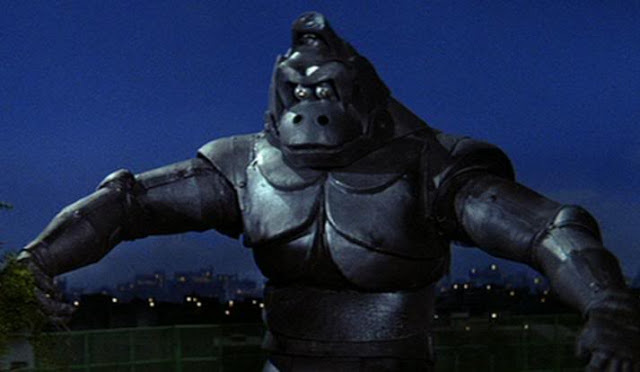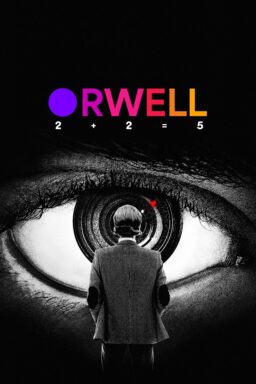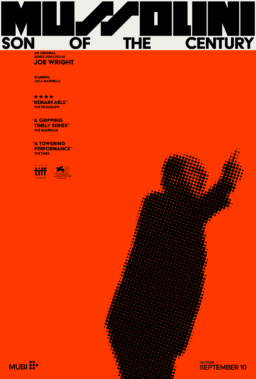“King Kong Escapes,” in which the giant ape is enslaved by a James Bond-style bad guy and made to dig for Element X and then fight his robot double, is the silliest King Kong movie ever made and one of the most enjoyable. One of my favorite vernacular phrases from the ’80s is “stoopid fresh,” which according to the definitive explanation by one of my high school classmates at the time, a dude named Adario, describes a ridiculous thing that is so surprising and striking that its ridiculousness is canceled out and only awesomeness remains. “King Kong Escapes” is a stoopid fresh monster movie. As you watch it, any initial instinct you might have ridicule it will give way to appreciation. You will laugh at its silliness but also at its audacity, and in time you will admit that its silliness is a form of audacity. Like many classic Japanese monster films of the era, it is blithely unconcerned with convincing you that anything in its running time could actually happen. As a result, you believe in every frame. You enter the dream.
This movie was released in Japan in 1967 and internationally the following year. It was directed by Ishiro Honda, the man behind a number of Toho Studios epics, including the original “Godzilla,” aka “Gojira.” It has all the hallmarks of a Japanese monster film made during that era, including monsters that are obviously guys in suits tromping across intricately designed miniature landscapes and bashing each other while citizens run away from rear projected images of their exploits. I have never seen “King Kong Escapes” on a big screen. It’s playing June 17 at New York’s Anthology Film Archives as part of “Simian Verite” series, a refreshingly old school programming idea that groups together films that happen to have one thing in common (in this case, the presence of an ape) and then leaves us to draw connections between them. A complete schedule can be found here; suffice to say that I’m going to see this one as well as the 1976 “King Kong,” which is also part of the “Simian Verite” series, in glorious 35mm. No force on earth can stop me.
I first saw “King Kong Escapes” when I was ten years old on local TV, edited for time and interrupted by ads. It was the Jimmy Carter era, an amiably sleazy period of American history. Disco was the soundtrack, PG movies had gory murders and topless women in them, people on network sitcoms made jokes about cocaine and swingers, and the lapels of men’s shirts were wide enough to land planes on. I subscribed to Famous Monsters of Filmland magazine and read Ray Bradbury paperbacks and dreamed about dinosaurs and monsters. “King Kong Escapes” was everything a shlock-loving ’70s kid with a chili bowl haircut could have wanted. By that point I’d already fallen hard for the 1976 “Kong,” produced by Dino de Laurentis, and read about the 1933 original (which I would not actually see until I was a teenager).
But as much as I enjoyed the bits where the giant ape fell in love with a human woman, battled a giant snake/dinosaur/etc., broke free of his chains and did battle with Army helicopters/biplanes atop the Twin Towers of the old World Trade Center/the Empire State Building and whatnot, the rest of the films had too much talking about philosophy and beauty and corporate ethics and yadda yadda yadda to hold my attention. I did not care about the humans in any of these movies, period. In fact I resented them, because they were getting between me and the giant creature rampages I desperately wanted to see. I matured a little bit on this issue, but not consistently. There are times when you want a movie to glory in suggestion and tactical delays, and then there are times when you just want to see the monster already. When you’re a little kid, you’re always in the second mode.
“King Kong Escapes” was a lot closer to the Kong films I devised in my feverish little brain while playing in the sandbox with a set of animal and dinosaur action figures (including a pose-able gorilla who played the role of Kong). It also feels just a tiny bit like “Kong: Skull Island,” a title that doubles as a set of search engine optimization keywords. By that I mean that my Kong stories made no logical sense, even by the relaxed standards of science fiction, and there wasn’t much plot or characterization getting in the way of all the stomping and roaring and destroyed huts, which were represented by acorns pressed just deep enough into the sand that their tops evoked thatched roofs. “AiiieeEEEEEE!” the villagers always screamed as Kong’s plastic foot mooshed their homes into the earth.
But I digress.
The bad guy in “King Kong Escapes” is named Dr. Who. The British TV jokes and Abbott and Costello jokes both write themselves, but that won’t stop me from writing some here. Who constructs a robot version of Kong (I don’t know who, Matt—you tell me!) to dig for an essential world-ruling substance, Element X, at the North Pole. The North Pole is the only place you can find Element X, apparently. The robot ape suffers mechanical failure and Who decides to kidnap the real Kong, bring him to the North Pole and finish the task. (Matt, can’t you just tell me the name of the bad guy?)
In a seemingly-unrelated-but-not-really parallel plot, a team of Americans arrives via submarine at Mondo Island (formerly Skull Island, until it was renamed by real estate developers, probably) and encounters Kong and various prehistoric creatures that are mainly there to fight Kong. Kong has a brawl with a Gorosaurus and breaks his jaws open at the end, like the original Kong does with a Tyrannosaurus Rex in the 1933 version, and like the 2005 Kong does with one of three T-Rexes that he tussles with. The director makes this borrowed moment his own by adding a simultaneously disgusting and naive touch: the dead lizard’s broken mouth spills over with foamy saliva bubbles that look like the ones I used to create with Mr. Bubble in my bathtub.
This Kong’s face, by the way, doesn’t look like a gorilla face, but more like somebody took comedy and tragedy masks and glommed them together, laid it like a Halloween mask over the face of some thick-necked, block-headed defensive lineman, and framed the result a mane of fur. This Kong is an exceptionally weird-looking Kong, even more so than the one in “King Kong vs. Godzilla,” which is saying a lot. From certain angles he looks like a sad old man who is thinking back wistfully on his childhood even while fighting a robot double of himself. The robot double’s face looks roughly like Kong’s, of course, but it’s rigid and gleaming, with a grim set to its jaw. I need to admit to you here that I hated Mecha Kong on first glance. I might hate Mecha Kong just as much today. He’s the metallic ape version of the kid who gets elected class president and is beloved by his teacher but turns into a bully the instant adults aren’t around.
For real. Spend five seconds staring at his face and tell me I didn’t call this.
Where were we? Ah, right: Who shows up (Just tell us his name, Matt!!!!) and kidnaps Kong and takes him to the North Pole to finish digging up the Element X that he needs to conquer humanity/destroy the Earth/redeem his Subway coupons/whatever. I’m not entirely sure why Who didn’t just kidnap the real Kong in the first place rather than go the the trouble of building a robot replica of him to dig for Element X, and it’s late at night and I am too tired to look up the answer, so let’s just chalk it up to him not really thinking things through and say that he did it because of distortion in the outer atmosphere having to do with Donna Summer and her sister Debbie Fall. Yabbata yabbata higgledy piggeldy, and yeah, so, anyway, Mecha Kong and King Kong end up fighting each other on top of Tokyo Tower. This is, by any scientific measure, a frickin’ awesome sequence. There are even miniature police cars and other emergency vehicles racing around the miniature Tokyo Tower, which looks to have been pretty huge even by the standards of a monster movie miniature.
Also, Mecha Kong has a miner’s flashlight type thing on his head that can shine a hypnotizing beam into King Kong’s eyes, or something. I might be remembering this part wrong. There are a lot of gaps in my memory of this film. But it’s OK, because I’m going to see it again very soon, with stoopid fresh eyes.












